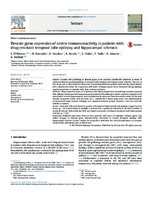Resumen:
Purpose: Granule cells pathology in dentate gyrus, have received considerable attention in terms of understanding the pathophysiology of temporal lobe epilepsy with hippocampal sclerosis. The aim of this study was to determine the nestin (an intermediate filament protein expressed by newly formed cells), immunoreactivity (IR) in granular cells layers of hippocampal tissue extirpated during epilepsy surgical procedure, in patients with drug-resistant epilepsy.
Methods: Hippocampal sections of 16 patients with hippocampal sclerosis and drug-resistant temporal lobe epilepsy were processed using immunoperoxidase with antibody to nestin. Archival material from 8
normal post-mortem hippocampus, were simultaneously processed. Reactive area for nestin-IR, the total number of positive nestin cells per field (20x), and the MGV (mean gray value) was determined by computerized image analysis (ImageJ), and compared between groups. Student’s t test was used for
statistical analysis.
Results: Nestin-IR cells were found in granule cells layers of both controls and patients. Larger reactive somas (p < 0.01) were found in epileptic’s sections but a significant reduction in the total number of nestin-IR cells per field and in the MGV was found in granular cells layers of patients with hippocampal sclerosis (p < 0.01).
Conclusion: Reduced expression of nestin-IR in granular cells layers of epileptic’s dentate gyrus may reflect changes in dentate gyrus neuroplasticity associated to chronic temporal epilepsy with hippocampal sclerosis. Further studies are required to determine the clinical implications on memory
an emotional alterations such as depression.
Descripción:
Fil: Kochen, S. Hospital de Alta Complejidad en Red El Cruce Dr. Néstor C. Kirchner. Centro Nacional de Alta Complejidad en Neurociencias y Neurocirugía. Florencio Varela, Argentina.

